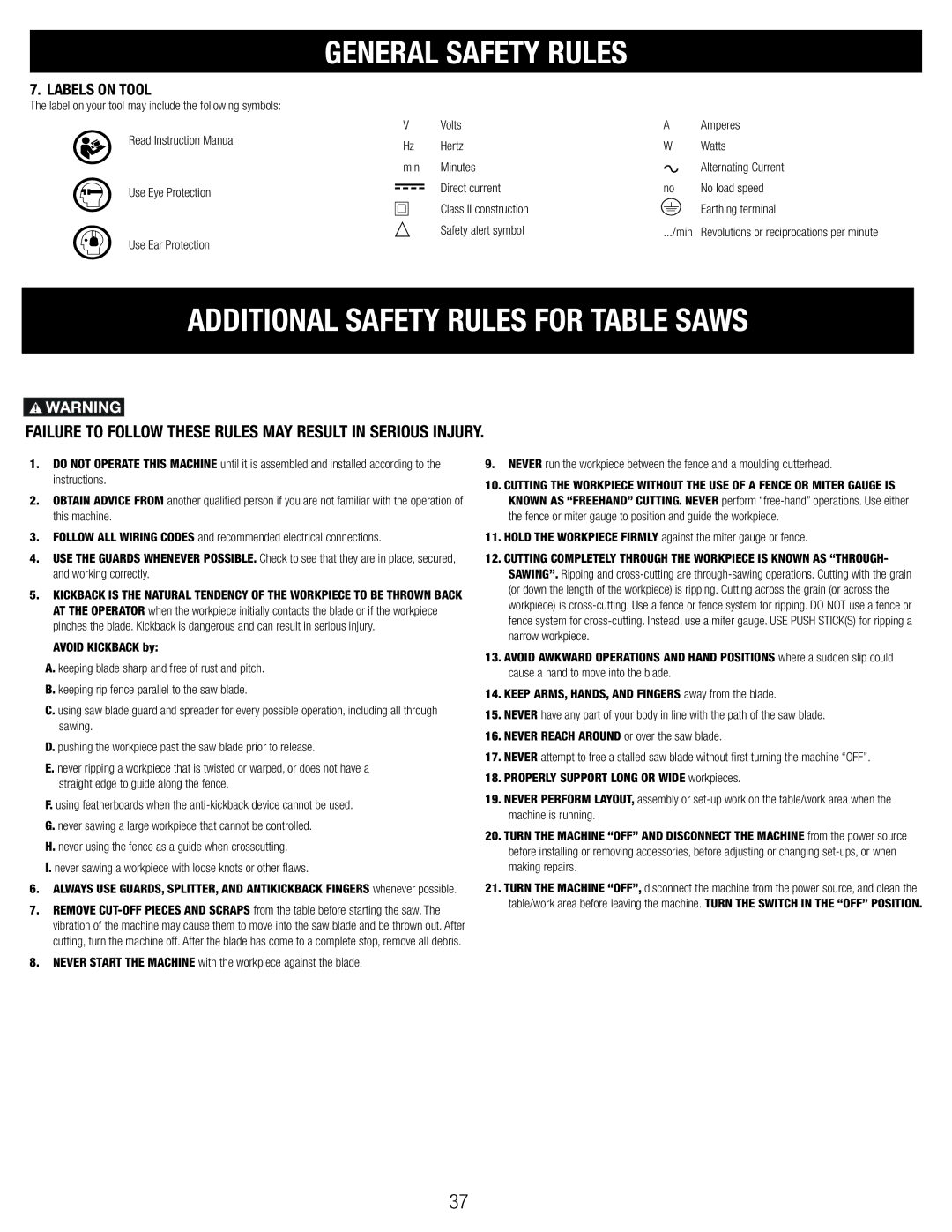
GENERAL SAFETY RULES
7. LABELS ON TOOL
The label on your tool may include the following symbols:
Read Instruction Manual
Use Eye Protection
Use Ear Protection
|
| V | Volts | A | Amperes | |||||||||
|
| Hz | Hertz | W | Watts | |||||||||
|
| min | Minutes |
|
|
|
|
|
| Alternating Current | ||||
|
|
|
|
|
|
| Direct current | no | No load speed | |||||
|
|
|
|
|
|
| ||||||||
|
|
|
|
|
|
| ||||||||
|
|
|
|
|
|
| Class II construction |
|
|
|
|
|
| Earthing terminal |
|
|
|
|
|
|
|
|
|
|
|
|
| ||
|
|
|
|
|
|
| Safety alert symbol | .../min | Revolutions or reciprocations per minute | |||||
ADDITIONAL SAFETY RULES FOR TABLE SAWS
FAILURE TO FOLLOW THESE RULES MAY RESULT IN SERIOUS INJURY.
1.DO NOT OPERATE THIS MACHINE until it is assembled and installed according to the instructions.
2.OBTAIN ADVICE FROM another qualified person if you are not familiar with the operation of this machine.
3.FOLLOW ALL WIRING CODES and recommended electrical connections.
4.USE THE GUARDS WHENEVER POSSIBLE. Check to see that they are in place, secured, and working correctly.
5.KICKBACK IS THE NATURAL TENDENCY OF THE WORKPIECE TO BE THROWN BACK AT THE OPERATOR when the workpiece initially contacts the blade or if the workpiece pinches the blade. Kickback is dangerous and can result in serious injury.
AVOID KICKBACK by:
A.keeping blade sharp and free of rust and pitch.
B.keeping rip fence parallel to the saw blade.
C.using saw blade guard and spreader for every possible operation, including all through sawing.
D.pushing the workpiece past the saw blade prior to release.
E.never ripping a workpiece that is twisted or warped, or does not have a
straight edge to guide along the fence.
F. using featherboards when the
H. never using the fence as a guide when crosscutting.
I. never sawing a workpiece with loose knots or other flaws.
6.ALWAYS USE GUARDS, SPLITTER, AND ANTIKICKBACK FINGERS whenever possible.
7.REMOVE
8.NEVER START THE MACHINE with the workpiece against the blade.
9.NEVER run the workpiece between the fence and a moulding cutterhead.
10.CUTTING THE WORKPIECE WITHOUT THE USE OF A FENCE OR MITER GAUGE IS KNOWN AS “FREEHAND” CUTTING. NEVER perform
11.HOLD THE WORKPIECE FIRMLY against the miter gauge or fence.
12.CUTTING COMPLETELY THROUGH THE WORKPIECE IS KNOWN AS “THROUGH- SAWING”. Ripping and
13.AVOID AWKWARD OPERATIONS AND HAND POSITIONS where a sudden slip could cause a hand to move into the blade.
14.KEEP ARMS, HANDS, AND FINGERS away from the blade.
15.NEVER have any part of your body in line with the path of the saw blade.
16.NEVER REACH AROUND or over the saw blade.
17.NEVER attempt to free a stalled saw blade without first turning the machine “OFF”.
18.PROPERLY SUPPORT LONG OR WIDE workpieces.
19.NEVER PERFORM LAYOUT, assembly or
20.TURN THE MACHINE “OFF” AND DISCONNECT THE MACHINE from the power source before installing or removing accessories, before adjusting or changing
21.TURN THE MACHINE “OFF”, disconnect the machine from the power source, and clean the table/work area before leaving the machine. TURN THE SWITCH IN THE “OFF” POSITION.
37
